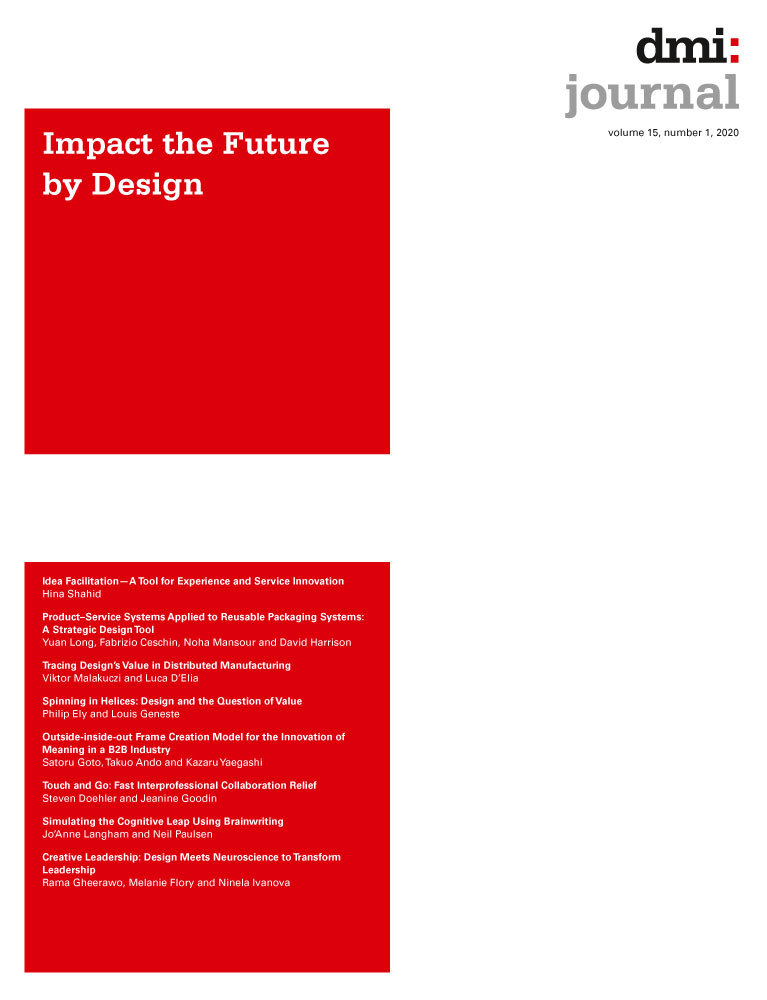Simulating the Cognitive Leap Using Brainwriting
Abstract
Idea generation and brainstorming are most effective when conducted in groups and in person. However, in-person co-creation activities have many limitations. The digital environment provides opportunities to ideate remotely and to enhance creativity. We designed an online experiment to assess the impact of brainwriting on the effectiveness of ideation. Our intention was to determine whether remote digital brainstorming could improve ideation, harnessing diversity in experience and knowledge while problem solving. Results revealed that unusual and novel ideas occurred in approximately 53 percent of cases using our simulated environment. Compared to the presession control activity, ideas generated were more sophisticated and included improvement in all cases. Our experiment demonstrates that digital brainwriting can significantly improve the quality and quantity of new ideas.
1 Introduction
1.1 COVID-19 and digital collaboration
Our research investigates the digital development of new ideas or the creation of a concept based on imagination at the point of insight, known as the cognitive leap. Understanding creativity is imperative for innovation and to advance civilization. Organizations are constantly seeking ways to improve, generate, and collate new ideas (Aurum and Gardiner, 2003; Elsbach and Stigliani, 2018; Mickahail and Aquino, 2019). The need to solve problems and for rapid innovation have become essential for businesses. A major focus of innovation is toward sustainable designs and systems that produce little or no waste and have a positive impact on the planet. The process of generating ideas is assumed to occur spontaneously, and all that is needed is to capture existing ideas (Dahlander and Gann, 2010). Conversely, idea generation occurs through a meticulous process of provocation, triggers, and the priming of participants based on the exploration of a well-developed and understood problem (Vrgović and Jošanov-Vrgović, 2017). However, simulating creative group processes in a digital environment is now a priority because of the sudden and necessary shift to physical distancing due to the COVID-19 pandemic. In this paper, we demonstrate the effectiveness of brainwriting in enhancing the creative process in a digital environment.
Group face-to-face brainstorming or ideation is extremely difficult during a crisis where people cannot meet in person or must observe distancing rules. Due to the need to work from home and continue working with colleagues, many people are using digital tools that were once optional but are now a core part of their primary work. The pandemic has forced many industries online in a very short period of time, including health, education, and entertainment (Marr, 2020). The use of online creative and collaborative tools has surged, with many of the leading providers of digital tools supplying free or extended access to users; examples include Zoom, Microsoft (Teams), Google (G-suite), and Cisco (Webex) (Marr, 2020). These well-known tools provide support to manage creativity or collaborate with other people online. However, such tools do little to facilitate imagination or creativity, to solve problems with more ingenuity, or to trigger cognitive leaps. There is also a lack of “meta-creativity” in the field of design creativity and ideation, stifling the development of solutions to question traditional design methods (Crilly, 2019). Our study addresses this challenge.
2 Background
2.1 Creativity research
Research into innovation and creativity has accelerated since 1997.1 However, the field itself has fragmented and expanded in multiple directions without any sign of reconciliation (Hennessey and Amabile, 2010; Simonton, 2012). The lack of integration of creativity research has been detrimental to the development of digital tools that effectively support the idea generation process (Javadi and Gebauer, 2019). As a field, investigators have approached creativity from a number of perspectives, including neurology, affect, cognition, behavior, education, personality, groups and teams, social environment, culture and society, and from a systems perspective (Hennessey and Amabile, 2010; Sawyer, 2011b). Development in our understanding of various issues such as design fixation has also advanced our knowledge of the creative process (Crilly and Cardoso, 2017). These explorations have also provided significant developments in our understanding of the cognitive and social factors that trigger and enhance the creative process. Many myths concerning creativity have also been debunked. We now know that creativity is not a product of the right–left brain distinction, but that creativity is a whole of brain activity (Dietrich, 2015, p. 18; Sawyer, 2011a). Creativity is not mystical; instead, it is firmly based in the everyday cognitive processes that are also used for noncreative actions and thinking (Sawyer, 2011b). We also know that memory and experience are important for creative insights, as the brain uses its predictive capability to simulate and test concepts to solve problems and create scaffolding for idea generation (Dietrich, 2015, p. 107). The brain also uses analogies or metaphors to generate new or different solutions to problems as part of the creative process (Holyoak and Thagard, 1995, p. 34).
2.2 Creative process
Generally, creative work has several parts: problem identification, problem framing, idea generation, idea evaluation, and idea selection (Wang, 2019). Creativity is transdisciplinary and is a core component of the ideation processes in the arts and is also necessary for the development of innovation in the sciences (Klein, 2017). Creativity is used in design and engineering methods and is usually noted in activities involving “ideation,” “design,” or “idea generation.” Many methods can be used to stimulate creativity and the creative thought process and are categorized according to aspects such as paradigm preserving, stretching, and breaking (McFadzean, 1998); jumping, pumping, and dumping (Knoll and Horton, 2011); group or individual (VanGundy, 1988); and activities focused on brainstorming, brainwriting, and Theory of Inventive Problem Solving (TRIZ) (Ilevbare, Probert, and Phaal, 2013; Wang, 2019). Tools such as ThinkLets can also be used to generate customized approaches to facilitating idea generation (Briggs, De Vreede, and Nunamaker, 2003; Knoll and Horton, 2011).
Face-to-face creativity and processes dominate creative work and are still perceived as the most effective, even in learning environments (Donaldson, 2020). Despite the advances in understanding creativity, we have seen little progress in applying research knowledge to improving the creative process in the production of information systems (IS). Creativity is difficult to simulate in the digital environment, and attempts to replicate the real-world environment, such as collaborative platforms and online spaces, have been disappointing. Software development tools that attempt to enable creativity are known as computer-supported collaborative environments (CSCE), group support systems (GSS), or creativity support systems (CSS). Many tools enable creative people to do artistic or creative tasks (e.g., Adobe creative tools) or to collaborate (e.g., Slack, Basecamp, Mural), but few tools facilitate the process of idea generation and creative insight that effectively utilize provocation methods such as brainstorming, the KJ method (Aurum and Gardiner, 2003), or TRIZ (Chai, Zhang, and Tan, 2005). Most of the tools have been developed for academic simulation and experimentation (Liikkanen, Kuikkaniemi, Lievonen, and Ojala, 2011). The main commercially available tools that facilitate creativity are Groupmap, Stormz, Powernoodle, and MeetingSphere (Keith, 2020).
2.3 Progress in digital or online creativity
Electronic brainstorming or e-brainstorming systems (EBS) have been slow to evolve and meet the needs of the market. E-brainstorming refers to the use of tools such as e‑mail, web chat, instant messenger, social media, and videoconferencing to gather ideas (Dennis, Minas, and Bhagwatwar, 2013). Some digital tools have the potential to perform greater support for the brainstorming process. E-brainstorming is a misnomer, as most of these tools gather ideas but do not further extrapolate, combine, or converge ideas in the creative process. The ways digital systems engage people in the creative process include (1) management of creative work, (2) communication for collaboration activities, (3) enhancement of creative techniques, and (4) creativity during idea production (Lubart, 2005). Creativity during idea production is poorly demonstrated in the current commercially available systems.
Neuroscientist Arne Dietrich (2015, p. 188) believes the reason for the lack of momentum in this direction is that we do not know enough about the mechanisms brains use to generate creative thought and therefore reproduce the process in a “silicon machine.” However, commentary from users of these tools provides insights into other deterrents, such as EBS being a “cold” process, being oversold as a “cure-all,” requiring keyboarding skill, loss of power for senior people, loss of social interaction, overload during idea editing, cost of facilities or software, and not all topics being suitable for such a platform (Gallupe and Cooper, 2018). The user interface of the tool also has a significant impact on not only the creation of new ideas but also the integration or combination of ideas (Javadi and Gebauer, 2019). Liikkanen et al. (2011) believe that the wane in popularity of e-brainstorming tools may be due instead to the innovation process stalling when ideas have been collected but then require extra effort to operationalize.
2.4 Group creativity
Recent research into group creativity provides inconclusive findings about the effectiveness of approaches. Some researchers believe diversity in groups enhances creativity (Sawyer, 2011, p. 234). Conversely, research also shows that diversity can decrease the overall effectiveness of group functioning, as it complicates relationships, increases the likelihood of conflict, and reduces the potential to achieve group consensus (Knight et al., 1999). The social and interpersonal interactions of groups counteract the potential of creativity through diversity.
E-brainstorming tools have the potential to reduce or remove the negative effects of group work while enhancing the range and quality of ideas by accessing large crowds of diverse people from within and outside of traditional organizations and groups. However, research into e-brainstorming sessions generally uses small groups of people (maximum 10–15 people) and replicates, rather than enhances, the face-to-face process (Gutwein, 2013). For example, Santanen, Briggs, and De Vreede (2014) tested the cognitive network model of creativity (CNM) using 61 groups of four people. The experiment used the e-brainstorming tool from GroupSystems for Windows WorkGroup and focused on the importance and complexity of idea integration. Experiments restricted to small groups do not demonstrate the potential of capturing the experiences and knowledge augmentation of large groups of participants.
Crowdsourcing is a further online method for individuals or organizations to utilize large groups of people to seek nontraditional solutions (Wang, Nickerson, and Sakamoto, 2018). Some organizations, such as Dell, have their own products for capturing ideas generated through their user innovation community (UIC)2 (Di Gangi, Wasko, and Hooker, 2010). Used in this manner, the idea capture tool can reveal an organization’s willingness to listen to and engage with their community. However, this process also has disadvantages, such as lack of detail provided by participants, poor written communication, idea duplication, influence of minority opinions on idea selection, feedback on uptake of ideas, and difficulty in sustaining the user community (Di Gangi et al., 2010).
2.5 Crowdsourcing and open innovation
Crowdsourcing and open innovation are worthy approaches for citizen engagement and creativity for public policy and administration. The inclusion of citizens in the idea generation process provides both a wealth of additional ideas and solutions as well as citizen ownership in the development of solutions that affect them directly. However, the administration of co-design or creative techniques has a significant impact on the success of the event or contest (Silva, 2015). Factors that negatively impact co-design sessions include (1) the external context, (2) the project design, (3) internal (to organization) resources, and (4) the culture and structure of the delivery organization (Van Lancker, Wauters, and Van Huylenbroeck, 2019). Public co-design activities may also require significant manual documentation, transcription, and synthesis to complete the design process.
Idea generation and creative activities are often more effective with the introduction and exposure of partially formed ideas requiring further collaboration to fully shape solutions (Javadi and Gebauer, 2019). However, open innovation usually enables sharing of well-developed or complete ideas. Crowdsourcing and open innovation rely on individuals or small groups to conduct their own processes for idea generation and the creative process. Furthermore, crowdsourced ideas often use rewards and incentives to motivate participants for idea generation. Research shows that extrinsic motivators may pervert the effectiveness of the idea generation process (Walter and Back, 2011). A growing body of research exploring the elements required for successful crowdsourcing and open innovation process focuses on the collection of ideas already generated, and on the selection or prioritization of ideas. However, little research explores the most appropriate mechanisms to generate ideas through the digital platform.
An EBS has the potential to overcome many of the confounding factors for creativity in face-to-face brainstorming, such as social conformity (Liikkanen et al., 2011; Stroebe, Diehl, and Abakoumkin, 1992), social loafing (Buisine, Guegan, and Vernier, 2017), production blocking (Minas, Dennis, Potter, and Kamhawi, 2018), or evaluation apprehension (Gabriel, Monticolo, Camargo, and Bourgault, 2016). Furthermore, a well-designed EBS provides a structured method for people who do not have access to trained design facilitators to assist in shaping and managing group processes as well as ensuring the completion of necessary methodological steps. EBS may also improve the data capture and synthesis process, providing rapid and more effective idea generation.
To investigate these concerns and possibilities, we designed a study based on the core primary criteria for idea generation from Knoll and Horton (2011): including group size (large), using both random variation and creative synthesis, and employing a mixture of group membership (both introverted and extraverted). We also sought to overcome the inefficiency factors for group creativity, including production blocking, social loafing, and self-censorship (Buisine et al., 2017). We examined whether creative insight could be improved using EBS and assessed the benefits of using online brainstorming in comparison to face-to-face brainstorming.
3 Research context
We created an online simulation of the brainstorming and creative process in the context of massive online courses (MOOCs) using a form of the brainwriting process that used a combination of pool and gallery brainwriting (Aiken, Vanjani, and Paolillo, 1996). We investigated whether the simulation could progress innovation or design-led activities that are traditionally reliant on social interaction and stimulation through conversation. The original aim of the research was threefold: (1) to assess whether outputs from traditionally sized workshops would be more creative with greater group participation (2) to determine whether crowdsourced participation in e-brainstorming would generate quality ideas and not junk text or dummy data from participants attempting to shortcut or bypass complexity due to social loafing, and (3) to determine whether e-brainstorming would produce quality output in an anonymous, distributed, and socially isolated setting.
The simulation occurred twice in a period of six months. During each version of the simulation, participants engaged with different challenges. We invited participants to provide solutions in free-text fields. These solutions were subsequently assigned randomly to other participants for their input, and to build and improve the concepts received using the improvisation theater technique of “yes and …”(Crossan, 1998; Moshavi, 2001; Mourey, 2020). Participants could further refine and adjust their ideas before final submission. We also expected all participants to assess and rate the ideas of 2–3 other participants. We used these ratings on several characteristics to generate a prioritization score for ideas. After three people had evaluated each idea, we presented participants with the overall score for each idea. Participants could determine the effectiveness of their ideas and how they contributed to other people’s ideas as part of the process.
4 Methodology
Our research design utilized a mixed-methods approach to data collection and analysis of the simulation data. We collected both qualitative and quantitative data through online brainstorming simulations during MOOC sessions in April–May and September–October 2018. Participants from the Leading High Performing Teams3 (edX) course engaged in the activity as part of the practical activities built into the course. Participants interacted with the MOOC interface and submitted comments and answers through the tool created specifically for the simulation. The tool was specifically designed for the simulation as a low-fidelity, text-based form interface and used a workflow to manage each step of the process. We used the double divergent-convergent approach to idea generation as the basis of the simulation steps (Cropley, 2006), implemented problem framing (Schon and Wiggins, 1992), and attempted to create the strategic design process as noted by Ball and Christensen (2019).
We followed the same procedure using different scenarios. Before entering a simulation, we invited participants to describe possible solutions to a problem similar in complexity and content to the later challenge. This prompt created a baseline of responses for idea generation before the coursework video intervention and the subsequent brainstorming session. Following this prompt, participants viewed a 10-minute video providing theory on creativity and the process of understanding a problem, analyzing influencing factors, and the design approach to ideation. Participants then accessed the scenario and problem to address. In the first scenario (Figure 1), we invited participants to generate new ideas for transporting a newly purchased rug that was too large to transport home in their normal vehicle. In the second scenario, we tasked participants with the challenge of generating ideas to improve the departure process at airports. Only the first scenario is reported here.
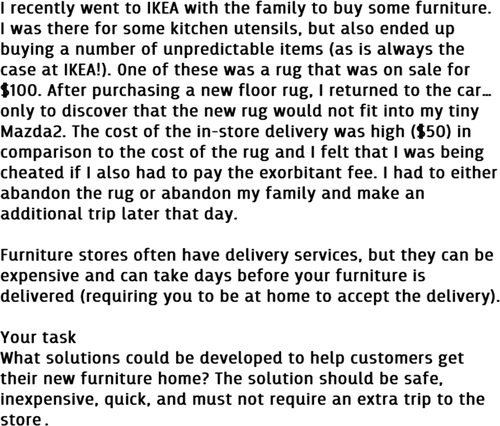
In each of the scenarios, we provided participants with a focal area to consider. Participants viewed each problem from the perspective of conditions that were important to addressing the challenge such as (1) cost—minimizing cost while solving the problem, or (2) time and convenience—ensuring rug delivery in the quickest, easiest manner. We asked participants to generate three separate ideas and then combine their ideas or synthesize their ideas into one solution. To overcome dropout and minimize social loafing, we assigned each solution randomly to another participant to improve and expand on the original idea. Before proceeding to the next step, each participant received two ideas randomly from other participants. Participants noted expansions to the ideas and returned the ideas to their originator. The original idea owners or creators reviewed the changes and noted any additions to their own ideas to see whether these could be enhanced a second time. Finally, each participant used any combination of the ideas to come up with their final integrated solution, which they submitted to the group for review and assessment.
After completing the idea generation and expansion steps, each participant randomly received three ideas from other participants to rate on the following criteria: creativity, practicality, convenience, and cost. Each criterion attracted a score from 1 to 5. We weighted each of the criteria evenly and generated the final rating as an average score of ratings across the criteria. After all steps were completed, participants received the rating and evaluation for their final idea as rated by their peers. Finally, we invited each participant to comment on the process and describe their perception of the value of online brainstorming or brainwriting. The brainwriting process is shown in Figure 2.
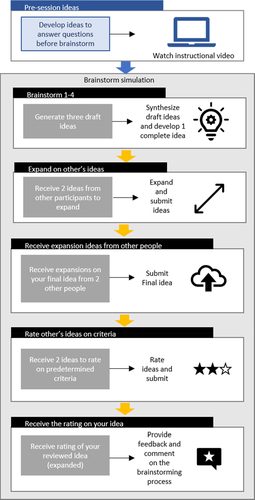
5 Analysis
The MOOC was open to anyone globally with access to the edX interface. Participants provided their responses anonymously. Sixty course participants completed the online simulation activity.
For initial screening, we extracted data from the simulation environment and imported it into Excel. We used SPSS to analyze the quantitative data and MAXQDA for coding and analysis of the qualitative data. After we screened the quantitative data set for missing data and incomplete answers, 58 usable responses remained for analysis. Of these responses, we categorized 25 as relating to solutions focused on time and 34 related to ideas focused on reduced cost. We then analyzed the data in several ways: thematically, according to variable, and by chronological steps according to respondent (case).
We created variables according to each step in the simulation process. We labeled each suggested solution by the sequential order of the idea (Table 1). The first idea was called “idea 1,” the second “idea 2,” and so on. We labeled participant combinations of their own ideas as “self-selection.” Where participants added information or further detail to another person’s ideas, we labeled them as “adding value.” When participants received information from another person, we labeled that response as “integration.” We labeled any further combination of ideas as “self-selection 2.”
Randomly assigned ideas from other participants attracted a rating out of 5 (1 = low, 5 = high) on creativity, practicality, convenience, and cost, providing a total score for the idea out of 20. Each idea was rated by three participants. We averaged each of the scores before providing a total average rating for each idea. No missing data occurred in the quantitative variables.
| Variable name | Description |
|---|---|
| Presession idea | Ideas generated before the training and without the brainstorming process |
| Idea 1 | First draft brainstorming idea |
| Idea 2 | Second draft brainstorming idea |
| Idea 3 | Third draft brainstorming idea |
| Self-selection of idea (4) | Combined overall idea created out of the first three brainstorming drafts |
| Adding value | Suggestions that were made to other participants |
| Integration 1 | Idea provided by one other participant to add value to the self-selected idea |
| Integration 2 | Idea provided by one other participant to add value to the self-selected idea |
| Self-selection 2 (integration of all previous ideas) | Final idea created by the original participant where they use their own idea and suggestions from other participants |
We created and applied codes incrementally for suggestions in which the idea content was similar, but participants had described the ideas using different words or in a different manner. If a participant noted the name of a specific service such as an Uber or a taxi, we added an additional distinct code. We also provided additional codes to distinguish the specificity of the idea. When coding was complete, we conducted complex coding queries on each of the variables in MAXQDA, selecting any code within the variable range. We extracted query results as Excel and CSV outputs. We used SPSS to screen the data and conduct basic statistical analysis and then Excel to combine the variables into one data set to compare the change in frequency of code per step in the process. We again imported this data set into SPSS for analyses of variance. We applied SPSS auto-recoding to each of the variables in the simulation process. This process created one variable with all the manual codes assigned a number. We then created a grouping variable for each of the simulation steps to compare idea generation around specific topics for each simulation step. We also examined each of the cases for the top-rated ideas (ratings of 15–17) to identify any points where ideas or suggestions changed or improved idea generation and quality across individual participants.
6 Results
During the simulation, we randomly allocated participants to a focus area for the brainwriting. Due to the randomization algorithm, the Cost group included more participants (57.6 percent) than the Time group (42.4 percent). Overall, the Cost group generated significantly more individual ideas (or recombined variations of ideas) than the Time group (Table 2).
| Number of ideas | Valid percent | Cumulative percent | |
|---|---|---|---|
| Cost | 488 | 63.6 | 63.6 |
| Time | 279 | 36.4 | 100 |
| Total | 767 | 100 |
6.1 Presession results
The presession responses demonstrated that participants applied the most obvious, stereotyped or “heuristic” solutions for the delivery problem. The majority of responses (65 percent) were predominantly in four categories: (1) get the store to deliver the goods, (2) ask a friend to help, (3) use an Uber or a taxi, or (4) hire a vehicle to transport the goods. Figure 3 shows the percentage of responses that suggested each idea category. Only 5.4 percent of ideas were unique (i.e., only noted by one person).
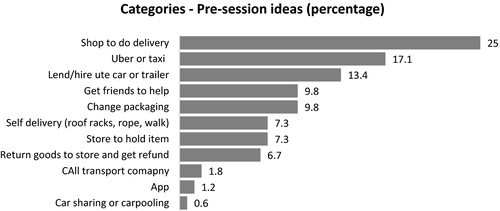
Figure 4 shows both groups (Time, Cost) had similar ideas for solving the problem before watching the instructional video on ideation and brainstorming techniques. Even though participants generated more presession ideas (Figure 5), these ideas were all related to the small number of categories shown in Figure 4. Only one observable difference occurred between the groups’ trends: participants with a Time focus suggested a taxi or an Uber, whereas participants with a focus on Cost suggested returning the goods to the store for a refund.
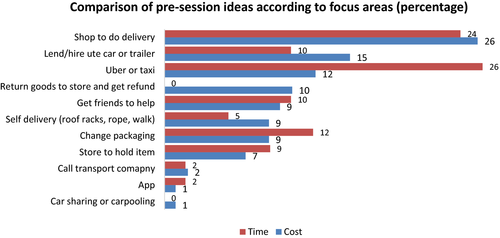
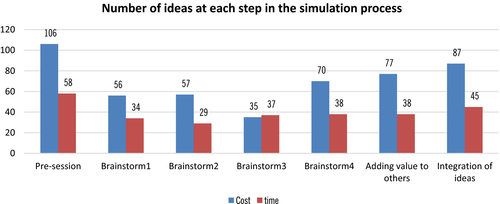
6.2 Round 1: three ideas
In the first round, participants generated three ideas (Brainstorms 1, 2, and 3), considered to be “drafts” of their ideas. They then reviewed and synthesized their ideas to submit as Brainstorm 4 (self-selection 4). During this session round, the Cost focus area generated 148 ideas, which participants synthesized into 77 ideas for submission. The Time focus area participants generated 100 ideas that they synthesized into 38 ideas for submission.
Participants’ initial ideas were thematically close to the presession ideas: Uber/taxi, getting the shop to deliver, self-delivery using straps, getting friends to help, and hiring a utility vehicle or a trailer. Some unusual ideas appeared as first suggestions, such as the use of drones, brokering of services, disassembling the goods, changing packaging, and car sharing.
In the second set of draft ideas (Brainstorm 2), participants also suggested other unusual ideas, including disposable roof racks/carriers, service depots for collection of goods, and apps with delivery tracking. Brainstorms 1 and 2 also generated a similar number of ideas (56:35 and 57:29 as a ratio of cost:time). However, with the final drafting of ideas (Brainstorm 3), the Cost group produced far fewer ideas (35) and the Time group more than previous drafts (37).
In addition to the previous rounds, the third brainstorming round added new ideas, including providing additional information for shoppers up front or at the checkouts, delivery options with times to be booked, and discounts for other customers to proivde the delivery for you if they live in close proximity.
Each of the draft sections also had many unique idea suggestions. Brainstorm 1 unique ideas included delivery options provided on a sliding scale of cost, swapping furniture assembly for delivery, GPS tagging on hire trailers, free delivery days (based on geographical location), and autonomous vehicles for delivery. Brainstorm 2 unique ideas included Airtasker commercial sharing, Uber Big, attach item to car grill, security boxes for storage and collection, and discounts offered for online shopping. Brainstorm 3 unique ideas included Segways, 3D printing at home, valet, and cleaning option for use of shared trailer/car.
6.3 Round 1: self-selection of idea (4)
The finalization round (Brainstorm 4) had 40 ideas that were unique. Most ideas also mentioned some form of Uber/taxi service, the use of an app, sharing costs with other customers, brokering, and autonomous vehicles. Unique ideas included GoGet one-way share vehicles, shop-provided renewable energy–powered electric vehicles (for hire), different versions of Uber (e.g., Uber fits, Uber furniture, Uber parcel delivery), and additional points that included details on functionality that would be used in an app to support the management of deliveries.
6.4 Round 2: adding value
In this step, we asked participants to generate suggestions to improve or expand other ideas. Two ideas had been randomly assigned to each participant to address. The popular shared expansions included the use of ideas relating to Uber, car sharing, and an app. However, additional unique ideas included a flying carpet, teleporting, specially designed trailers or carts, carts that returned to the store autonomously, delivery cost to be included in the sales price, and additional functionality for an app such as choosing the size of the delivery vehicle to fit the goods.
6.5 Round 3: integration of ideas
The final integration step produced the greatest number of total idea suggestions (other than the presession step). Of the 132 responses, participants generated 46 ideas or idea characteristics; 24 of the 46 ideas (52 percent) were unique. The use of Uber in some way was included in approximately 40 suggestions (6 different ideas), and the use of an app featured in 21 suggestions (5 different ideas).
After the integration of the ideas, a strong trend emerged away from ideas relating to the shop managing or resolving the delivery problem and similarly for people doing “self-delivery.” Ideas in the integration round were more detailed and had more focus on vehicle or delivery service sharing, complete solutions, the use of an app for booking, and features that were not mentioned in the presession idea generation step.
6.6 Rating of ideas
After the final integration step, participants submitted their idea for rating on the criteria and for feedback. The sum of scores across the four criteria could achieve a maximum score of 20. Three participants rated each idea, and we calculated the final score for each idea as an average of the three participant ratings. The highest average score was 17 and the lowest was 6.33. The overall mean score for final ideas was 12.8 (SD = 2.22). The results are shown in Figures 6 and 7. The Cost focus area had a mean score of 12.6 (SD = 2.38); the Time focus area had a mean score of 13.1 (SD = 1.86). Mean scores were not significantly different across groups. However, future research should investigate the difference in quantity of ideas in comparison to the quality of ideas. Future research should also ask participants to self-report on the difficulty of the focus area to determine whether perceived complexity in the topic impacts the overall generation of ideas.
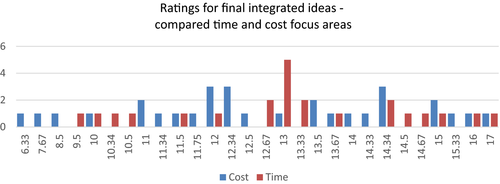
6.7 Review of the ideation process for the top ideas
The top nine ideas (rated > 15 out of 20) demonstrated an evolution of ideas based on the simulated brainstorming process within the tool. Table 3 shows the detailed idea development that occurred in each step of the brainstorming process for the highest rated idea (17/20). This idea was scored  = 4.5 for creativity,
= 4.5 for creativity,  = 4 practicality,
= 4 practicality,  = 4.5 convenience, and
= 4.5 convenience, and  = 4 cost.
= 4 cost.
| Top-rated idea, score 17, focus area: Time | Analysis comments | |
|---|---|---|
| Presession | I would research other options—does the shop offer a delivery option, could I book a taxi/Uber/ hire car, could the shop hold the BBQ for collection later when one of my friends is available? | Standard ideas |
| Brainstorm 1 | Provide an immediate delivery option (e.g., they follow you home with your purchase in their larger vehicle). | |
| Brainstorm 2 | Provide a service in which you can book delivery for a short window of time (e.g., 15-minute window) and at times including outside of hours. | |
| Brainstorm 3 | Have trailers for hire that can be taken immediately and the company will collect later. | |
| Brainstorm 4 | Uber delivery. | Idea triggered by draft brainstorm |
| Adding value | Ikea to partner with AirTasker to have people who have capacity to pick up and deliver the items and, for an extra fee, install the furniture. | Suggestion by other user to add to the idea of Uber |
| Adding value | I could turn my car with roofracks into an Uber-style delivery service. | Suggestion of other participant as addition to Uber |
| Adding value | A delivery service similar to Uber but independent of the shops—people simply log into the app, enter the pickup/drop-off location, the size of the item for transport, and a photo. | Suggestion by other user to add to Uber |
|
Integration (final idea) |
A delivery service similar to Uber and Airtasker—people simply log into the app and input their details (e.g., pickup/drop-off location, size of the item for transport, photo; do they just need transport or are they also interested in someone assembling it for them as well). | Combination of ideas |
The presession idea was similar to other participants’ responses, quoting standard solutions to the delivery problem. The first idea demonstrates an attempt to address the problem with the focus on reduced time (e.g., get a delivery truck to follow you home), which met the criteria of convenience (for the participant). The second idea was a variation on the first idea: if the delivery could not be done immediately, a second option would be to book the delivery at a time that was convenient to the participant. These two options both relied on the provider to assist with the delivery. The third option changes the locus of the responsibility to the participant—enabling them to do the delivery themselves, but still relying on the provider to collect the transportation mechanism after use. The final synthesized idea submitted was Uber delivery.
Other participants expanded on the original idea, introducing concepts from their own brainstorms, such as Airtasker (where they would also install the item), using roof racks, and a variation on Uber delivery with an app.
The final idea presented for rating was a combination of the ideas that had been introduced at each step. The participant picked the best points of each idea and added them to their own. Table 4 shows the final ideas that were rated over 15/20.
| Idea description (final integrated idea) | Score | Focus | |
|---|---|---|---|
| 9 | Share a truck or vehicle that delivers all the items in your area using an Uber-type app. You pay for your part of the ride while others pay for their part only (as when you share a taxi ride). You can decide at what time you want to receive the item; it is also good to have internet tracking so you can see where the truck is at the moment with your goods and an ETA to your house | 15 | Cost |
| 8 | Uber deliveries, transport companies bidding for lowest cost of transport (customer experience rated/reviewed), using renewable electrically powered vehicles to keep their cost down. Delivering smaller and lighter flat-packed, unassembled furniture for lower cost and easier handling. | 15 | Cost |
| 7 | App for pooling transportation with other customers using an Uber-like service | 15 | Time |
| 6 | Shoppers can try out the item in store, but their purchase order is sent from a remote warehouse somewhere else (like IKEA, but without the warehouse at the bottom level). Shipping is direct to your home, same-day (if in the city), and free … but that shipping is affordable because of the significant savings of not having to store items at the shop. It would be like buying online at Amazon, but with the ability to browse and test the products in person. | 15.25 | Time |
| 5 | Courier ride-share application allowing people to deliver on their own time with their own cars. Customer receives low-cost, fast delivery of furniture. | 15.33 | Cost |
| 4 | Rent the space extender to use with your car or with an Uber if you do not have time to go to your home or space if you’re going to buy at another shop. | 16 | Cost |
| 3 | A van equipped with a 3D printer can be booked to drop by your place and print out the parts for your furniture. | 16 | Time |
| 2 | Online platform for delivering big packages (e.g., Uber Big) | 17 | Cost |
| 1 | A delivery service similar to Uber and Airtasker—people simply log into the app and input their details (e.g., pickup/drop-off location, size of the item for transport, photo; do they just need transport or are they also interested in someone assembling it for them as well). Registered drivers can then provide a quote and the customer picks whatever appeals the most to them (e.g., cost vs. how soon they are available vs. their skill level at additional tasks requested, such as assembly). | 17 | Time |
6.8 Feedback from participants on the digital brainstorming process
Most participants commented on the value of stepping through the thinking process and evaluating, recombining ideas, and refining without judgment.
7 Limitations
We did not design the simulations to be a comprehensive assessment of the e-brainstorming process. The simulations were designed as a proof of concept for creating future brainstorming tools that could be used to support online learning and workshop design environments. Additional features are known to enhance the brainstorming process but could not be easily built into the simulation tool. For example, additional brainstorm filters, lenses, or triggers could be used to enhance the online brainstorming process; enabling users to be identified rather than anonymous; and gamification of the final scoring (with a leader board) are all features that were outside of the scope of the simulation. The use of transparent and visible group feedback may impact the overall assessment of safety that some participants perceive.
Due to the nature of the simulation as part of an online course, we did not collect any identifying data. Therefore, we could not analyze whether demographics were influential on productivity or effectiveness of the e-brainstorming process. We were also unable to identify whether factors such as socioeconomic status, location, gender, or education had an impact on the efficacy of the brainstorming outcomes.
8 Discussion and conclusion
We conducted this experiment to determine whether e-brainstorming could increase creativity in online idea generation using larger than normal workshop groups (more than 30 people). In addition, we wanted to determine whether the digital tool would create high-quality idea output, determine whether the tool would overcome social loafing that occurs in group processes, and assess the impact of anonymity on creativity and idea generation. We also hypothesized that creativity would be provoked through a deliberate constrained process.
All final ideas generated from the e-brainstorming process were significantly different from the presession ideas. Furthermore, 53 percent of final ideas were unique. Most of the obvious ideas generated presession were abandoned after the initial drafting of the first three ideas. Participants reported an improvement in their own thinking process and how they developed ideas; that the tool helped them overcome their own thinking bias; and that it increased their individual creative confidence. The results also demonstrated the influence of existing knowledge and metaphors on the idea generation process. Many people referred to the use of innovations such as Uber, taxis, or apps as part of the model to build their solution. Participants also used fantasy concepts to extend ideas (e.g., flying carpets and teleportation). The use of referents was an important part of the creative process.
The simulations revealed a diverse range of possible solutions and many original ideas. The digital environment provided an opportunity for participation regardless of location and was accessible to all who agreed to participate. The simulation showed that the brainwriting process was effective in the digital environment when used with the correct stimulus and the appropriate process and feedback mechanisms for participants. Very few participants (three) provided minimal answers without much detail. However, these “free-riders” did not appear to have an impact on the group creativity process. Ideas provided by these participants were absorbed by the group and extended. Social isolation did not appear to impede the creative process. In some cases, participants noted that they felt “safer” in the anonymous and remote environment.
A significant advantage of the online environment was the detailed preparation of description and division of the problem into segments for focus areas. Understanding and defining problems so that focused ideation can occur is a necessary step for the success of the digital brainwriting process. The focus areas also impacted the group outcome. The Cost group generated more ideas, but the Time group generated higher-quality ideas. Therefore, it is likely that focus areas are important to idea generation, and poorly developed focus constructs will add complexity to the ideation process. Future research should identify tools that assist with problem definition and understanding for improved digital collaboration.
The online environment also provided mandatory focus on extension of other people’s ideas. As ideas were randomly assigned, participants were forced to contribute to an idea despite individual perceptions of value or quality before moving on to the next task. The use of the improvisation theater technique—where it is necessary to build on ideas that were unrelated, diverse, and obscure from a participant’s own concepts—compelled additional creativity for participants to complete the task. The feedback of expanded ideas enabled the original idea to be advanced and developed without fear of judgment. Final ideas contained supplementary detail not normally included in traditional face-to-face brainstorming processes. Furthermore, the structured digital process meant all ideas were automatically captured, categorized, and expanded, creating efficiencies in documentation of brainwriting outputs.
We were also able to engage a large group of users (58) in the e-brainwriting process, which demonstrates the possibility of harnessing massive online crowds to generate ideas. Future research should extend the sample to groups of 500 or more to see whether the number of unique ideas increases in proportion with the size of the group, or whether the group naturally reaches a saturation point where no new ideas are created. Larger size groups for ideation would also potentially bring greater diversity and therefore more creative ideas (Sawyer, 2011, p. 234). The identification of the optimal group size would aid the innovation process within organizations that have access to large workforces to potentially generate ideas.
Additional approaches to stimulating ideas or in combining ideas add value to the idea generation process. Researchers have attempted to apply standardized, predetermined focus areas or topics to stimulate the idea generation process with some success (Faste, Rachmel, Essary, and Sheehan, 2013). The workflow created in our digital process requires participants to consider ideas outside of their original thoughts and expand in unexpected directions. The digital environment provides significant efficiencies and advantages in documentation, synthesis, and the removal of socially created bias due to perceptions of peer judgment. Functionality such as this could be significantly enhanced with artificial intelligence (AI) by predicting patterns in the problem-solving idea generation and then applying these patterns in future ideation sessions. Further research is needed to clarify the best mechanisms and characteristics to be incorporated into EBS as well as the development of tools that support each step of the creative process.
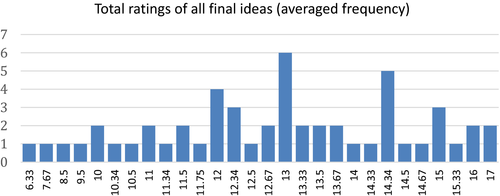
Biographies

Jo’Anne Langham is an innovator and has 26 years of experience in leading human-centred design teams. During her work in industry she established design teams and lead large scale public sector design projects. Jo’Anne was awarded the prestigious Australian Taxation Office Commissioner’s Scholarship (2010). Her recent research into creativity and innovation includes the development of the digital creativity tool: SparkTank.

Neil Paulsen is an Associate Professor in the University of Queensland Business School, Australia. His research interests include intergroup perspectives on leadership, teams, organizational behaviour and change. More recently, he has focused on human centred design processes in organisational change and service contexts. Prior to joining academe, Neil has more than 20 years experience as a successful senior manager and consultant in public, private, and community sector organisations and in international development contexts. He has a long-standing interest and involvement in all aspects of organisational life as a practitioner, consultant, and researcher.
References
- 1 Fifty-nine articles were produced in 1979, growing to a publication rate of 1,179 articles produced on creativity in 2019 (Web of Science, 2020).
- 2 Dell’s tool is IdeaStorm: http://www.ideastorm.com.
- 3 https://www.edx.org/course/leading-high-performing-teams.








